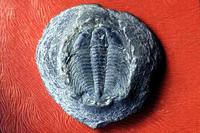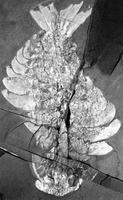Fossils
FOSSILS are at once fascinating and richly informative. They are used to date rock units and to gauge the passage of geologic time. Fossils furnish direct evidence about the nature of ancient environments and about the composition of past animal and plant communities. The fossil record provides the best information possible about the history of life and the course that evolution has followed. Moreover, to many people, fossils are natural images and sculptures of great beauty. Fossils have been collected for many years in the CORDILLERA. A trilobite on a rock wafer that could only have come from Cambrian shale east of CRANBROOK was found in a Coast Salish (see SALISHAN FIRST NATIONS) archaeological site in the FRASER Canyon. Likely picked up by aboriginal people a few thousand years ago, it must have been carried or traded 500 km across the Interior.
Significant fossils occur in BC in sedimentary rock assigned to each of the 13 geological systems from Vendian through Quaternary (650 million years ago to 10,000 years ago; see chart). Some sites preserve truly spectacular fossils of cardinal importance for charting the development of life on the planet. Middle Cambrian rocks on Mt Field in YOHO NATIONAL PARK include the celebrated BURGESS SHALE assemblages of exquisitely preserved arthropods, worms, SPONGES, MOLLUSCS, brachiopods and other groups, most with preserved soft tissues (see also WORLD HERITAGE SITES). Triassic strata near WAPITI LK south of TUMBLER RIDGE contain diverse assemblages of complete fossil fishes (including a coelacanth) and many extinct marine reptiles (ichthyosaurs and thalattosaurs). Fossil localities on eastern VANCOUVER ISLAND and the GULF ISLANDS have some of the most diverse faunal associations known from Upper Cretaceous rocks—ammonites, cuttlefish, bivalves, gastropods, crustaceans, marine reptiles (mosasaurs, ELASMOSAURS, turtles), sharks, crinoids, corals, INSECTS, a bird and a DINOSAUR, plus well-preserved fossil plants. Lower Paleogene lake beds in the PRINCETON, CACHE CREEK and WILLIAMS LAKE areas include superbly preserved fishes, insects, SPIDERS, birds, flowers, leaves and permineralized aquatic plants preserved in 3 dimensions.
Organized investigations of geology and systematic collection of fossils began when BC entered CONFEDERATION in 1871 and the Geological Survey of Canada (GSC) started its work in the Cordillera. The initial emphasis was on the geology and age of mineral-bearing regions on Vancouver Island, the QUEEN CHARLOTTE ISLANDS and the Interior. In the 19th century, fossils collected from these areas by James Richardson, George M. DAWSON and Alfred Selwyn were described by the GSC paleontologist J.F. Whiteaves and the McGill Univ paleobotanist Sir J.W. Dawson. In the 20th century, GSC paleontologists published major works on Paleogene plants and insects, Cretaceous molluscs and plants, and on Triassic and Jurassic ammonites of the Cordillera. West Coast paleontology became an academic discipline in 1921 with the appointment of M.Y. Williams as UBC professor of paleontology. The subject is now studied at 3 BC universities, at the GSC, at a few museums and increasingly by amateur paleontologists and fossil collectors belonging to the BC Paleontological Alliance. Many important BC fossils are studied outside the province by paleontologists at the Royal Tyrrell Museum at Drumheller, AB, the Univ of Alberta, the Univ of Saskatchewan, Cambridge Univ in England and the Royal Ontario Museum in Toronto, as well as the Canadian Museum of Nature in Ottawa. Major collections of BC fossils reside outside the country. The Smithsonian Institution alone holds 65,000 specimens from the Burgess Shale, while the American Museum of Natural History has many Triassic fishes from Wapiti Lk. Within the province there are modest or specialized collections at the ROYAL BC MUSEUM, Princeton Museum, COURTENAY Museum, KELOWNA Museum, HUDSON'S HOPE Museum, Vancouver Island Paleontological Museum (QUALICUM BEACH), Queen Charlotte Islands Museum and the Fraser Centre for Eocene Research (CHILLIWACK). Many of the museums display fossils.
by Rolf Ludvigsen
Readings: Rolf Ludvigsen, ed., Life in Stone: A Natural History of British Columbia's Fossils, 1996; Rolf Ludvigsen and Graham Beard, West Coast Fossils: A Guide to the Ancient Life of Vancouver Island, 1998.



